ITALY’S IDYLLIC LAKE GARDA
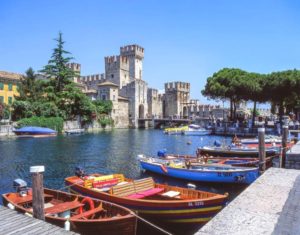
There aren’t many places in Europe more beautiful than Italy’s Lago di Garda. Its stunning scenery is due to the extensive backdrop of the Dolomite mountains to the north, together with all the picturesque towns and medieval villages dotted along its shore, it’s the perfect region to spend some time. It has long been a favourite destination of ours, and we tend to gravitate to the beautiful town of Sirmione on the southern shore, which is a great base to explore a number of the other gorgeous small towns via the lake ferries.
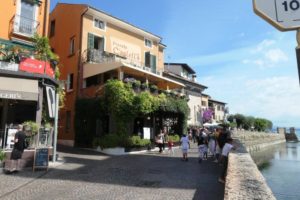
Lake Garda is Italy’s largest lake and easy to access, being half-way between Milan and Venice. We drove up from Ferrara, but there is a train that stops at Desenzano on the southern shore, buses from various towns such as Verona and Brescia that go to a number of towns, and there are also car ferries that cross the lake.

Sirmione’s location on a peninsula that juts out into the lake at its southern end is one of the most distinctive towns along the lake. Immediately recognisable due to the large 13th century Scaligero fortress castle at its entrance, it still has its drawbridge in place that gives the only access across the water-filled moat into the town.
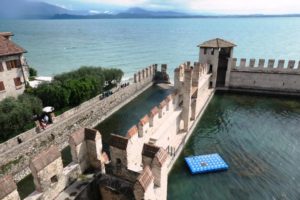
The medieval fortress was built by the Della Scala family of Verona, known as the Scaligeri, who needed to fortify their holdings against their numerous rivals. It was later controlled by the Republic of Venice from the 15th century, after they had defeated the Scaligeri in 1405. It continued to be used as an armoury, military barracks and fortification until the unification of Italy, when it became the office of the local government of Sirmione. Its restoration began after WWI when it became a museum and tourist attraction. On this visit, we decided to actually go up the steep, timber staircase inside the tower and out onto the ramparts to take in the spectacular view from the top. Definitely worth the effort!
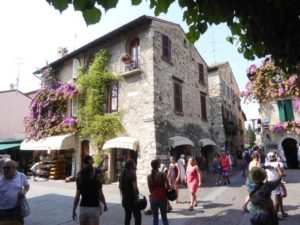
Aside from taxis and delivery vehicles, non-resident traffic is prohibited from entering Sirmione. Instead, there is a communal parking station just on the edge of town, from where your hotel picks you up in a golf cart. There are plenty of hotels right outside the town, but it’s well worth staying right inside the walls, as you can walk anywhere and everywhere from there.
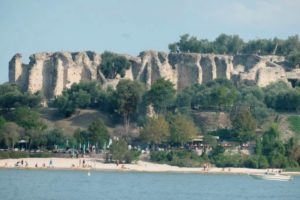
Sirmione is renowned for the extensive archaeological remains of a Roman villa called (incorrectly) the Villa Catullus, after the Latin poet of the late Roman Republic. He was born near Verona, and his wealthy family were known to have had extensive property holdings in the general region, and he referred to his beloved house in Sirmione. However, the villa at Sirmione dates from a later period, towards the end of the 1st century AD. Nevertheless, the site is fantastic, and the views overlooking the lake make for a spectacular visit.
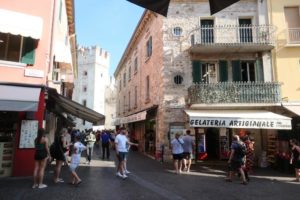
The winding streets of Sirmione are lined with attractive restaurants and, it seems, more gelaterias than anywhere else on earth, small boutiques and colourful houses, many decked with brilliant flowers, especially vivid bougainvillea climbing up walls. There are numerous lovely walks, particularly in the direction of the Villa Catullus, passing by beautiful hotels and villas with their lush gardens that passers by can also enjoy the sight, and all made especially pleasurable due to the town and the area around it being pedestrianised.
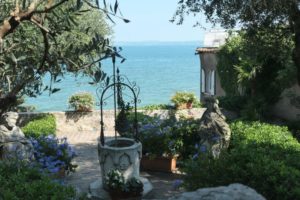
Sirmione has been a drawcard for its thermal spring that were famous since ancient times, the waters being rich in sulphur, bromine and iodine. There are a couple of very classy hotels offering lavish spa treatments along with their bars and restaurants with spectacular views of the lake. Read more about Sirmione on an earlier blog: https://parisplusplus.com/italy/sirmione-lake-garda-home-to-a-moated-castle-and-an-enormous-roman-villa/
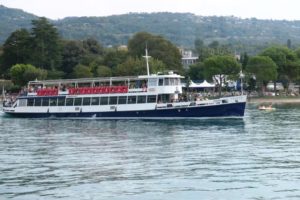
Sirmione enjoys an excellent ferry service to other towns on the southern end of the lake, but less so for those to the north, as the distances are quite long, too far and too infrequent for a day trip. Besides, those towns that are easily accessible for day trips are very rewarding.
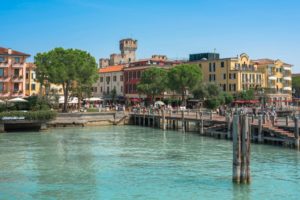
You can buy a ferry pass which allows a visit to three of the nearest towns, namely Garda, Lazise and Bardolino. Ferry tickets are purchased from the little ticket booth at the wharf, and there are also car ferries that cross the centre of the lake between Torri del Benaco and Maderno. There is a road all the way around the edge of the lake, but just for a relaxing day’s excursion, nothing beats the ferries.
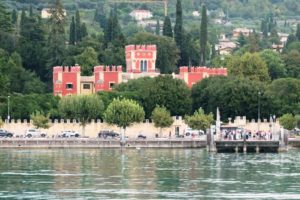
Garda is a lively resort town with great little boutiques, any number of trattoriae and restaurants, especially those along the tree-covered lakeside promenade, all perfect for a few hours exploring. It’s situated on a magnificent bay, surrounded by lush green hills and guarded by the rocky outline of the Rocca looming nearby.
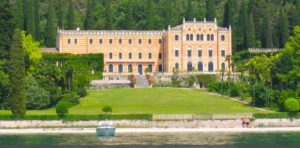
On the eastern shore just out of town, the Punta di San Vigilio is a picturesque promontory that stretches far into the blue waters, with a chapel, a small hotel, a small harbour, and the enchanting Sirens Bay “Baia delle Sirene”. At the end of an avenue of cypresses, on the lake’s edge, is the magnificent 16th century Villa Canossa. Said to be Garda’s most beautiful beach, Mermaids’ Bay is at Punta di San Vigilio.
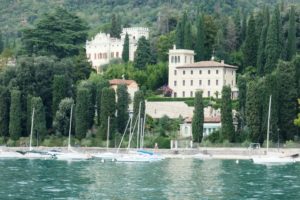
The town has an interesting ancient history dating back to the Bronze Age. Roman writers such as Virgil and Catullus knew and wrote about it when the lake was known as Benacus, and was associated with the cult of Neptune. The integration between the Romans and Cenomani, the local tribe who controlled the Garda area, probably began around 225BC, although the actual Romanisation of the area took place between the 2nd and 1st centuries BC. Germanic Ostrogoths were the first to build a fortification on the Rocca in the 5th century, and they were followed by other invaders until the town came under Venetian control, who promptly demolished the fortress.
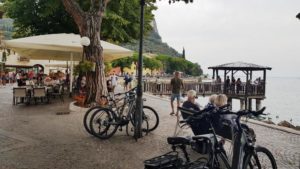
These days, a path through the trees on the edge of the town takes walkers up the Rocca and the statue of Madonna del Pino, and if you’re feeling energetic, cycling is very popular along the lake’s shores. There is a beautiful path, ideal for walking or cycling, that runs along the lake connecting Garda, Bardolino and Lazise, for a total of about 13 kms. This path is surrounded by nature, winding through the reed beds, perfect for meeting ducks, swans and mallards that populate the lake.
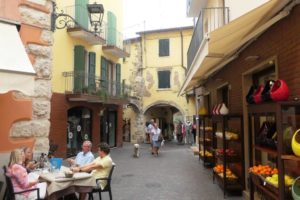
The Palazzo dei Capitano in town is a Gothic palace on the lake front and the square in front of the building was once the harbour before being filled in. This is now one of the town’s busy squares full of restaurant tables, perfect for enjoying a leisurely meal or an aperitif, or perhaps simply people-watching down by the waterfront while you take in a breathtaking sunset, for which Garda is famous. There is a weekly market that takes place every Friday where you can taste and buy numerous local products as well as fashion items.
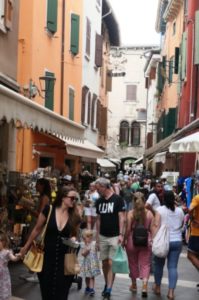
Tourism isn’t the only source of income for Garda though. The hinterland is full of olive groves and vineyards, while important summer festivals have much to do with the central place that fishing holds for the local people, going back centuries.
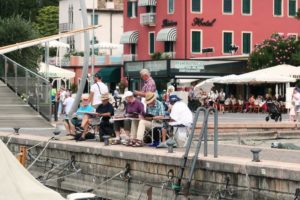
A few kms. to the south of Garda the ferry stops at Bardolino. As well as the sheer attractiveness of the town itself, Bardolino is celebrated for the production of oil and wine. With its own DOC classification, Bardolino is a highly regarded red wine produced in the south-east end of the lake. You can visit the many wineries in the area and do a tasting tour. During the year, Bardolino hosts several events dedicated to wine: Festa del Chiaretto in May, Festa dell’Uva in October and Festa del Novello in November.
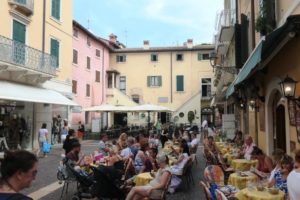
This part of Lake Garda is also known for its vast production of Olio del Garda (Garda Olive Oil), that’s characterised by a delicate and slightly fruity taste. If you’re fascinated by the process and history of the oil, there’s an olive oil museum at Cisano, 3 kms to the south of Bardolino, where you can taste and buy oil, whole olives, special vinegars and sauces. They also produce a very good range of skin care products based on the local oil, as well as olive wood objects such as salad servers, bowls, chopping boards and dishes.
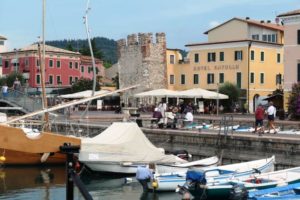
As the ferry pulls in you can see the vestiges of the walls of the citadel, built in the 12th century by the Della Scala family, lords of Verona. Observant visitors will notice the particular “herringbone” layout of the village, typical of fishing villages, where the streets develop perpendicular to the coast to easily bring the boats in for shelter.
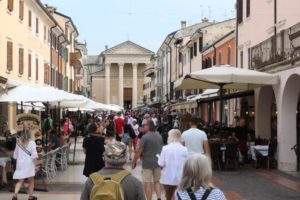
Bardolino is also famous for its many churches. Walking towards the hills behind the town you will find San Zeno, dating from the Carolingian period in the second half of the 9th century. Also notable is San Severo, a masterpiece of Romanesque architecture located at the northern entrance of the town. Built in 1109, it’s known chiefly for its beautiful frescoes.
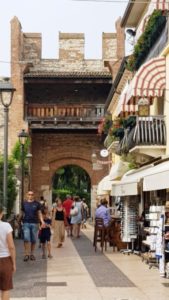
Today, the old town centre is delightfully lively, with bars, restaurants and smart shops—that stay open until late during the summer months—where you can indulge in the typical products of the area. If you’re in Bardolino on a Thursday morning, you can enjoy exploring the outdoor market that offers many local products set out in colourful stalls.

A further 6 kms along the lake the ferry comes to Lazise, almost opposite Sirmione, at the widest point of the lake. Known since pre-historic times, during the Roman era, Lazise was a village named Lasitium (meaning lake). In 983, Otto ll, the Holy Roman Emperor, granted the inhabitants of Lazise the right to build fortifications around the village, exempted them from paying certain taxes and granted them wide autonomy on economic and commercial matters such as fishing, transit rights and religious administration. Lazise is therefore considered the first Comune (state city) of Italy. In 1193 Lazise came under the control of the Municipality of Verona, but retained many of its ancient privileges.
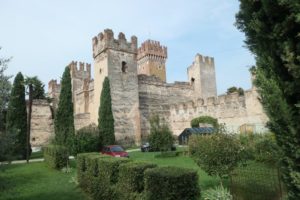
Lazise is a good example of a town which is still largely contained within the town walls, constructed in 1329 by the Scala family of Verona. The fortifications were constructed of stone, pebbles and a few layers of brick, with crenellated towers. At one time, there were 20 towers. Moats and drawbridges protected access into the town. In the mid 1800s the castle complex was purchased by a Count Buri, who began an important restoration program, so that today, the walls and towers are in a good state of conservation, and represent a perfect example of a typical Scala family era fortification. The turreted castle and keep, courtyards, two walled enclosures and six towers are still privately owned. However, visitors can walk along the walls, free of charge, that offer beautiful views of the town and the lake.
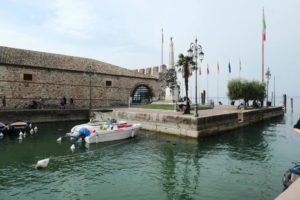
Lazise had considerable importance both as a commercial and a military port. In Venetian times, it kept two galleys constantly combat-ready. For this reason, the dock was fortified, and the access regulated by a large chain that could be raised and lowered. As one of the main ports for commercial traffic on Lake Garda, in 1600 the dock was equipped with a Customs House for the unloading and inspection of goods. This stone building is still there, on one side of the dock. It’s in excellent condition and now hosts fairs, presentations, and events of all kinds.
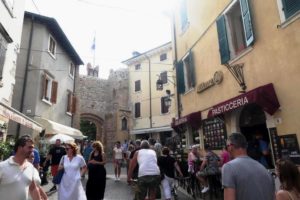
On the opposite side of the ferry pier, near the Customs House, is a simple and rather austere Romanesque church, dedicated to San Nicolò, patron saint of sailors—no co-incidence, since the inhabitants were almost exclusively fishermen and boatmen. A thorough restoration of the church in the 1950s revealed interesting frescoes in the style of Giotto.
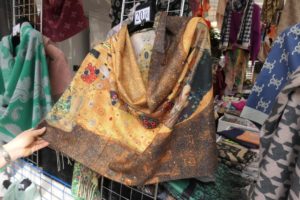
Today, Lazise is one of the most important tourism centres on Lake Garda, so much so that the Veronese consider it their “seaside”, since it’s barely half an hour’s drive from Verona. Lazise offers delightful walks along the lake shore and it’s a pleasant holiday pastime simply exploring the charming little alleys and squares of the old town, which offer very enjoyable shopping opportunities (think accessories, shoes, jewellery, fashion), or even just a gelato sitting by the lake while you wait for the ferry.
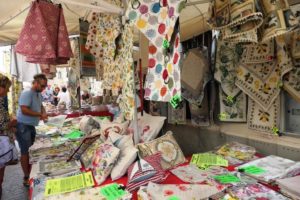
If you time your visit for a Wednesday, you can take advantage of the local market that takes place from early morning until around noon.
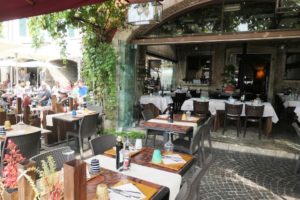
The villages and towns around the lakeshore all have a different character, and it depends on where you stay as to which ones are viable to visit. We’ve always stayed in Sirmione, but perhaps next time we’ll aim for one of the lovely options at the northern end, rather than just stopping off here and there for a few hours en route south. Lake Garda offers so many beautiful destinations, and at 54 kms long and with a perimeter of almost 160 kms the difficulty will be narrowing so many great choices to leisurely explore just a few!
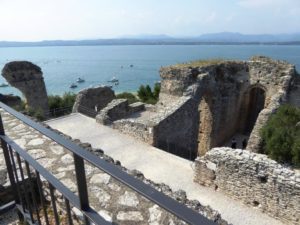


Thank you, Cheryl. This is just what I wanted to hear, as I’m now planning to fit in a few days to the Italian Lakes district, early June . I have been to Lake Como, but many many years ago. I have an Aussie friend, living in Milan, so hope to catch up with her.
Best wishes for enjoyable Christmas . Cheers, Lois
Hi Lois,
Glad the story came at a useful time for you! Do let me know if you’d like some more specific info., especially about beautiful Sirmione. Like you, we’ve spent quite a bit of time on Lake Como, always staying at Bellagio as it has so much to offer, aside from being easy to get to, but Lake Garda has so much to offer too. In fact, you could say that about all the Italian lakes, even the tiny Lake Orta, although we’ve never actually stayed there, only visited while either staying at Lake Maggiore, or passing through to/from somewhere else. All are beautiful, with so much to delight the visitor! I’m sure your friend in Milan knows them all very well.
Cheers, Cheryl
PS: I hope you too enjoy a happy and peaceful Christmas. We’re returning to Paris on 29 Dec. for a bit before heading down to Puglia. Can’t wait!
As always, a fascinating and tremendously well
researched read. Thank you.
Hi Nadine,
It’s a gorgeous part of the world, so it’s easy to research and write about somewhere as lovely as Lake Garda!
Thanks for your kind words,
Cheryl